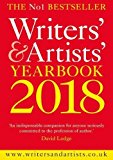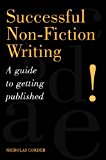This is the seventh installment of the non-fiction writing course. Last week we looked at how to write a feature article for magazines; this week we will be discussing:
Approaching editors and publishers
 Once you have an idea for an article or a book, you will need to do some market research to see who publishes what and who is accepting material. Check out a market listing such as the The Writers’ and Artists’ Yearbook for details. For more on the magazine market, see my article on the basics of feature writing.
Once you have an idea for an article or a book, you will need to do some market research to see who publishes what and who is accepting material. Check out a market listing such as the The Writers’ and Artists’ Yearbook for details. For more on the magazine market, see my article on the basics of feature writing.
Unlike the fiction market, many non-fiction publishers still accept proposals from authors, so you don’t have to use an agent. Nearly all magazines accept proposals direct from the writer although most of them do not welcome unsolicited manuscripts. All this means is that you shouldn’t send in the article without first asking permission to do so. For book proposals, you should send off a formal proposal either by email or post, according to the publisher’s specifications. You can determine this by checking out their author guidelines online, or phoning them and asking them how to submit something to them. If they want it by email, send it by email, if they want it through the post do so, if they ask for you to send it on camel back, don’t argue, just do it.
You may be fortunate enough to be put through to a publisher or editor to discuss your idea in advance, so make sure you have a telephone pitch worked out (see below).
Approaching magazine editors
When approaching an editor with an idea you will need a proposal. This can vary from a one-line phone pitch to an informal email pitch to a formal proposal. If you don’t have a track record with a magazine, a formal proposal is advisable. For subsequent articles you can take a less formal approach.
The phone pitch
Call the magazine (or publishing house), tell them you have a proposal or article idea and ask to be put through to the commissioning editor. You may be told to email or post a proposal at this point – find out exactly who to send it to. Don’t be satisfied with ‘The Editor’ or ‘Submissions’, try to get a name. If you are put through to the editor, make sure you have a single paragraph ‘pitch’ worked out. This is a two or three sentence summary of your book or article. What is it about? For example:
Would you be interested in an article about the Gypsy Royal Family? Your readers may not be aware, but up until the turn of the last century the travelling community on the Scottish / Northumberland border claimed to have their own royal line. They were considered quite a tourist attraction by the Victorian gentry and people would travel from London to visit the royal court.
Exercise 23:
In fewer than 50 words write a telephone pitch for your article or book idea.
The informal pitch
This is usually done via email after an editor has asked you to send them a few paragraphs on your idea. It is not a formal proposal, and is usually only used when you already have a track record with the magazine or have established that you are an experienced writer with ‘cuts’ (portfolio pieces of previously published material). For more on cuts and how to get them, look at my article on how to get started in feature writing. If you don’t have any cuts in print, you could always refer to your blog, particularly if you have written something in the same area for which you are pitching. A blog is a good place to start practising writing ‘proper’ articles and not just personal musings (see writing for the internet). But back to proposals.
How to write a magazine proposal
This consists of a covering letter and an article outline. In it you need to provide a short summary of your article (this may be the same as your telephone pitch), why you think it is suitable for that particular magazine, your writing credentials if you have any, a word count and whether or not images are available. Here is an example of a covering letter with additional suggestions of what you might say if you have little or no experience.
Exercise 24:
Draft a covering letter for your magazine article proposal.
The outline
With your covering letter you need to attach a summary of your article. It should include:
- A suggested title
- A suggested intro paragraph
- The main points of your article in bullet form
- A suggested conclusion
- Possible sidebars / text boxes
- Photographic possibilites
- Projected word count
- Your contact details (these should appear on the letter and outline as the two may become detached).
This is an example of an article proposal outline.
Exercise 25:
Draft an article proposal outline to go with your covering letter.
What next?
You may have to wait up to three months to get a reply to your proposal, particularly if you have sent it in by post. A telephone pitch or email proposal is likely to get a quicker response, but there are no guarantees. For the ethics of sending material to different publications and publishing houses, see the next session on copyright, libel and finance. But in the happy event of an editor saying ‘yes’ you should then enquire about:
- Rates and terms of payment. If this is not acceptable to you, don’t take it any further. Note that it is not considered appropriate to ask for rates of pay before an article has been accepted.
- Whether or not there will be a contract. NB some magazines will not send you a formal contract, so the editor’s emailed response to you will serve as such. Keep copies! If it is only agreed over the phone, ask the editor to send you a letter or email confirming rates and terms of payment.
- Confirm expected word count and whether or not it includes sidebars.
- Confirm picture format – digital, prints, slides or transparencies. If digital, 300 dpi is the industry standard. Confirm whether you are able to deliver this.
- Ask how the editor would like the copy and photos to be submitted. This may be on disc, via email or ‘hard copy’. If on disc or email, confirm the desired format eg .doc , .rtf , .jpg etc.
- Confirm the expected deadline and whether or not you can meet it.
- Check what ‘rights’ they expect to buy. This has to do with copyright and will be discussed in the next session. In short, beware of editors trying to buy ‘all rights’. You should usually only offer ‘First Rights’ so put this in your acceptance email or letter.
- As a first-timer, you may be asked to submit your article on ‘spec’. This means you have to write the piece with no commitment from the editor as to whether or not they will buy it. When you’re first starting out in the business, it is advisable to agree to this even though you run the risk of working for nothing if they turn you down.
- Whether commissioned in advance or asked to provide on spec, you should now write your article and meet your deadline!
Writing a book proposal
A book proposal is a much longer document than an article proposal. In it you are expected to provide information on the following categories:
- Scope and themes – what the book is about and why it is important. You should also include here the proposed word length (including foot notes) and structure.
- Intended readership
- Similar and competing titles – a list of related books, their publisher, date of publication, cover price and page count.
- Unique selling point – what makes your book different from other books on the market.
- Author bio and marketing opportunities – your writing experience, why you are equipped to write the book and any ideas you may have about how you can personally help with marketing and promoting the book.
- Possible endorsements. For example, if you are writing a book on rare birds and you know the chairperson of the Royal Society for the Protection of Birds, say so.
- Chapter outline. This should be one or two sentences on each chapter. Although you may not have written the book yet, the publisher needs to see that you have enough material to do so and an idea of how you will complete the book.
- Images – whether or not they will be included, how many
 There is a very useful chapter on writing non-fiction book proposals in Susan Page’s book, How to get published and make a lot of money (don’t let the crass title put you off!). And of course Nicholas Corder’s Successful Non-fiction Writing.
There is a very useful chapter on writing non-fiction book proposals in Susan Page’s book, How to get published and make a lot of money (don’t let the crass title put you off!). And of course Nicholas Corder’s Successful Non-fiction Writing.
Here is an example of a book proposal. A book proposal should also be accompanied by a covering letter which will be similar in layout to the magazine letter above. You should also include the first three sample chapters. Note, for non-fiction you don’t actually write the book in advance (thankfully!) but you do have to show you know what the book will be about. For more on this review the first session on why write non-fiction.
Exercise 26:
If you have an idea for a non-fiction book, start work on drafting a proposal. If you would like further input once you’ve written it, you may want to submit it to me for a critique at a reasonable rate.
What next?
 Initially, book publishers can take up to three months to get back to you. If they are interested in taking the project further, they will take the proposal through a series of committee meetings before making a final decision. This process can take up to 18 months before the book is finally accepted or declined. Note, you are not contracted at this point and risk doing a whole lot of work for nothing. However, if you are accepted, you will be commissioned to write a first draft. Do not start writing until you receive a contract. The moment you are offered a contract you can apply for membership of the Society of Authors who provide a free legal advice service (although membership will set you back £85 a year, it’s worth it). For more on publishing procedures and contracts read Michael Legat’s seminal An Author’s Guide to Publishing.
Initially, book publishers can take up to three months to get back to you. If they are interested in taking the project further, they will take the proposal through a series of committee meetings before making a final decision. This process can take up to 18 months before the book is finally accepted or declined. Note, you are not contracted at this point and risk doing a whole lot of work for nothing. However, if you are accepted, you will be commissioned to write a first draft. Do not start writing until you receive a contract. The moment you are offered a contract you can apply for membership of the Society of Authors who provide a free legal advice service (although membership will set you back £85 a year, it’s worth it). For more on publishing procedures and contracts read Michael Legat’s seminal An Author’s Guide to Publishing.
Next, in our eighth and final session we will be looking at copyright, libel and finance.
 Welcome to The Crafty Writer's free online non-fiction writing course, presented by Fiona Veitch Smith, a freelance journalist, editor, author, playwright, screenwriter and writing teacher. I hope that you'll see a dramatic improvement in the quality of your writing as you work through this course.
Welcome to The Crafty Writer's free online non-fiction writing course, presented by Fiona Veitch Smith, a freelance journalist, editor, author, playwright, screenwriter and writing teacher. I hope that you'll see a dramatic improvement in the quality of your writing as you work through this course.
Pingback: Non-fiction - how to write a feature article at The Crafty Writer
Thanks for including this topic in your course! I am wondering in my case, having already commenced with writing my grandmother’s memoir and planning to complete it regardless of having a publisher, do you recommend that I try to find a publisher now?
Hi Writinggb,
Memoirs are a different kettle of fish. Although technically non-fiction, they are still a story, and as such I think that a publisher might want to read the whole story before commissioning. It would be different if it were the biography of a famous person, as the publisher would want input on the angle you may or may not take. That being said, there’s no reason why you can’t feel the water now by sending out a few sample chapters. Who knows, you might get a bite! Do let me know how it goes. Fiona.
Thank you so much for this course.I have found it invaluble to date and look forward to following it through.
In your section on writing article proposals you mention making contact with the magazines to get the name of the person to whom proposals should be addressed. I have tried this twice when the information was not clear in the publication itself. I simply asked for the name and contact email but on both occasions I was told it was not policy to give out personal details and I was just told to submit the article. Is this often the case or have I just been unfortunate?
Dear Ann, it is often the case, but sometimes you’re lucky, so always worth a try. If you can get a name it increases your chances of being noticed when you send in your proposal. I often manage to get a name – maybe I’m just pushy!
Thanks, Fiona. I may give it a try after the holidays.
thanks so much.its been quite so helpful.
Hi. Thank you for your informative article! I had one question: If you email back your proposal, what is the best way to handle clips? Should you scan articles in and send them as attachments? Or just say that they are available upon request?
Hi Jeanine. If you have pertinent clips that put you in a good light, attach as pdfs otherwise they take up too much space as jpgs. You should probably have a digital file of all your clips converted to pdfs so you can just pick and choose as necessary.
Pingback: The dreaded covering letter at The Crafty Writer
Pingback: thursdaybram.com » Blog Archive » The Business of Freelance Writing Carnival, Edition 32
Thank you so much! This has been super helpful. Am looking forward to the next article on this course.
Hi Fiona,
Now that I have had one article published – thanks to your taught course – I obviously want to mention it when pitching my next proposal. What is the correct way to include a CUT – do I just give the name of the mag and which issue or am I supposed to attach the submitted version of the article? Trouble is, it was edited down so the only real version I have is a hard copy!
Thanks!
Hi Toni, and congrats on your first cut!!!! I scan my cuts into a pdf file then attach to my proposal email. If you struggle to get the pdf down to a small enough size, then you can import the pdf as an image into a Word file and send that.
Is this an application for that film writer job I sent to you?
Good luck with it.
Fiona
Yes it is. I’ve prepared 4 proposals for starters, if they don’t like those I’ll send another 4. I’ll be able to scan them, thanks!
Dear /sir .
I am just writing you this message so as to greet you first of all and how do you do ? please send me this full and long pages because I want to improve my language.
thank you for your assistance .have a great day .
Hello Hussein. I don’t have any other pages to send you than what is already here on site.
Fiona
Pingback: IC Iraq - new lifestyle magazine launches in Baghdad at The Crafty Writer
i would love if you could send me a formal way of writing a prosposal as a starter to all my clients.
Hi Oshin,
Please see my services page for my rates.
All the best,
Fiona
Hi Oshin,
Unfortunately that’s not something I can advise you about. I teach about writing articles. Good luck with it,
Fiona